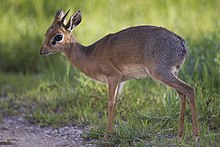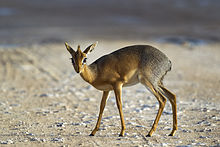Dik-dik
| Dik-dik | |
|---|---|
 |
|
| Male Kirk's dik-dik from Etosha National Park, Namibia | |
 |
|
| Female mate of the male dik-dik in the above picture | |
| Scientific classification | |
| Kingdom: | Animalia |
| Phylum: | Chordata |
| Class: | Mammalia |
| Order: | Artiodactyla |
| Family: | Bovidae |
| Genus: |
Madoqua (Ogilby, 1837) |
| Species | |
A dik-dik is the name for any of four species of small antelope in the genus Madoqua that live in the bushlands of eastern and southern Africa.
Dik-diks stand about 30–40 centimetres (12–15.5 in) at the shoulder, are 50–70 cm (19.5–27.5 in) long, weigh 3–6 kilograms (6.6–13.2 lb) and can live for up to 10 years. Dik-diks are named for the alarm calls of the females. In addition to the females' alarm call, both the male and female make a shrill, whistling sound. These calls may alert other animals to predators.
Female dik-diks are somewhat larger than males. The males have horns, which are small (about 3 inches or 7.6 cm), slanted backwards and longitudinally grooved. The hair on the crown forms an upright tuft that sometimes partially conceals the short, ribbed horns of the male. The upper body is gray-brown, while the lower parts of the body, including the legs, belly, crest, and flanks, are tan. A bare black spot below the inside corner of each eye contains a preorbital gland that produces a dark, sticky secretion. Dik-diks insert grass stems and twigs into the gland to scent-mark their territories.
Apparently to prevent overheating, dik-diks have elongated snouts with bellows-like muscles through which blood is pumped. Airflow and subsequent evaporation cools this blood before it is recirculated to the body. However, this panting is only implemented in extreme conditions; dik-diks can tolerate air temperatures of up to 40 °C (104 °F).
Dik-diks live in shrublands and savannas of eastern Africa. Dik-diks seek habitats with a plentiful supply of edible plants such as shrubs. Dik-diks may live in places as varied as dense forest or open plain, but they require good cover and not too much tall grass. They usually live in pairs in territories of about 5 hectares (12 acres). The territories are often in low, shrubby bushes (sometimes along dry, rocky streambeds) with plenty of cover. Dik-diks, with their dusty colored coat, are able to blend in with their surroundings. Dik-diks have an established series of runways through and around the borders of their territories that are used when they feel threatened.
Dik-diks are herbivores. Their diet mainly consists of foliage, shoots, fruit and berries, but little or no grass. They receive sufficient amounts of water from their food, which makes drinking unnecessary. Like all even-toed ungulates, they digest their food with the aid of micro-organisms in their four-chambered stomachs. After initial digestion, the food is repeatedly eructated and rechewed, a process known also as rumination, or 'chewing the cud'. Dik-diks' tapering heads may help them eat the leaves between the spines on the acacia trees, and feed while still keeping their head high to detect predators.
...
Wikipedia
